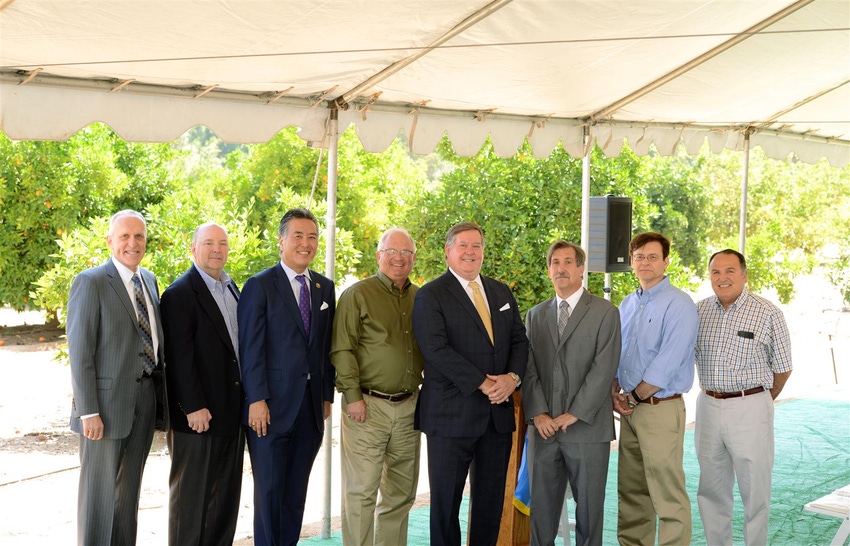
Recognizing the need for a high-level containment facility to perform critical citrus research the California citrus industry has commitments for $8 million from the private sector to build a quarantine lab near the University of California, Riverside campus.
Joel Nelsen, president of the California Citrus Mutual (CCM), said UC Riverside reached out to the citrus industry about a year ago seeking funding for a facility to conduct highly sensitive research to help find a cure for the disease Huanglongbing (HLB) and other challenges facing the American citrus industry.
Huanglongbing – sometimes called “citrus greening” – is a bacterial plant disease fatal to citrus trees. The disease has devastated citrus trees in Asia, South America and Florida. More recently, HLB has been found in Texas and California. So far, the only reported cases of HLB in California have been in residential citrus trees in the San Gabriel Valley metropolitan area in southern California.
According to Nelsen, the UCR was trying to obtain federal funding, but was unable to secure the estimated $12 million it would cost the university, as a public entity, to build a facility.
“Since they weren’t able to get the necessary funding, several of us in the industry started talking about it and recognized that there’s a lot of research going on specific to Huanglongbing, yet there’s no cure for it,” Nelsen said.
Moreover, Nelsen said the California citrus industry recognized that, even though research into the insidious bacterial disease in citrus is happening in Florida and at UC Davis, the Florida studies are more germane to Florida growing conditions and the UC Davis facilities are overtaxed with work done on a host of commodities.
“We felt that if we were going to protect ourselves we better take the lead,” Nelsen continued.
“We worked with Wonderful Citrus initially and then I contacted the balance of the industry and received commitments for funding.”
Citrus Research Foundation
From this effort the California Citrus Research Foundation was born, a subsidiary formed by CCM. The Exeter-based trade association will oversee the foundation as the executive secretary until an executive director can be hired.
Additionally, seven members of the citrus industry have stepped forward to serve as trustees of the organization. They include:
David Smith, Booth Ranches;
Harold Edwards, Limoneira;
Gerald Denni, Sunkist;
Jim Marderosian, Bee Sweet;
Etienne Rabe, Wonderful Citrus;
John Demshki, Corona-College Heights Orange & Lemon Association; and
Curt Holmes, California Citrus Mutual.
Designated alternates include:
Russ Hanlin, Sunkist;
James Sherwood, Bee Sweet;
David Kraus, Wonderful Citrus; and
Joel Nelsen, CCM
Though the facility is completely funded by the citrus industry, according to Nelsen, a partnership between the commercial industry and UCR will allow the Biosafety-Level 3 facility to be built near the UCR campus for the express purpose of finding a HLB cure.
The biosafety-level 3 plant facility will allow researchers, including many from UC Riverside who are experts on citrus pests, diseases and breeding, to conduct work with plant pathogens that previously couldn’t be done in southern California. The only other such facility is located at UC Davis near Sacramento.
According to Nelsen, the facility is “overtaxed” with multiple projects and not in close proximity to the rest of the citrus industry. UCR has a century-long track record of studying citrus. The university is home to the first citrus research station in California and currently houses the Citrus Clonal Protection Program.
In early June, the citrus industry gathered near the UCR campus for a groundbreaking celebration.
UC Riverside Chancellor Kim Wilcox discussed the establishment in 1907 of the Citrus Experiment Station in Riverside. The station eventually grew into the UCR campus. The research station received a boost after a 1913 freeze devastated the citrus industry.
“Now, unfortunately, 100 years later, we have a different kind of natural threat,” Wilcox said. "It’s not weather in this case but an insect. Again the university, the federal government and private partners have come together and said ‘We can address this.’”
During the celebration, Nelsen outlined the devastation that HLB has caused in Florida, Brazil and Mexico.
“That’s why it’s so important we forge this partnership today,” Nelsen said at the event. “That’s why it’s so important that we work together on the federal level, the university level, the state level and within the industry to stop this insidious disease.”
Rep. Ken Calvert, R-CA, of Corona called building the containment facility a long-term investment that will help the fight against HLB and agricultural pests.
“There is going to be another insect down the road,” Calvert said. “This isn’t the last one. The world is a small place. We need these containment facilities to fight these future onslaughts.”
Rep. Mark Takano, D-Calif. of Riverside, echoed Calvert’s statement.
“We’ve got to do our utmost to stop this disease,” Takano said.
Nelsen expects the facility to be completed by June 2017. It will be solely dedicated to finding a cure for HLB.
“We’ve told UCR that once we find a cure for Huanglongbing then we’ll consider allowing access for other types of projects for other commodities,” said Nelsen.
About the Author(s)
You May Also Like






